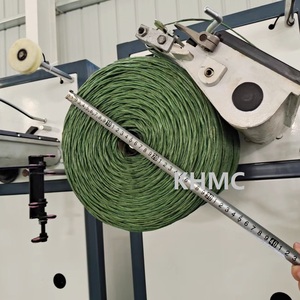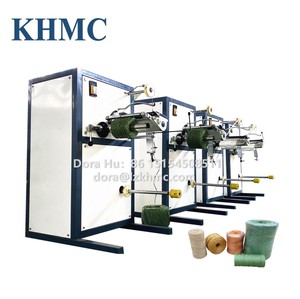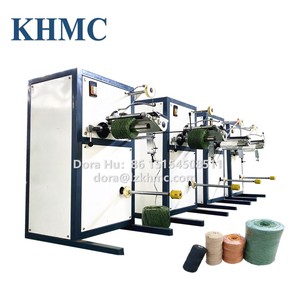
All categories
Featured selections
Trade Assurance
Buyer Central
Help Center
Get the app
Become a supplier

(2055 products available)



























Market Overview: The filament winder market has been experiencing notable expansion, paralleling trends observed in the broader coil-winding machine sector. According to Research and Markets, the global coil-winding machine market grew from USD 4.89 billion in 2023 to USD 5.23 billion in 2024, with projections suggesting a continued growth rate of 7.00% CAGR, potentially reaching USD 7.86 billion by 2030. This growth is significantly driven by the increasing demand for advanced filament winding solutions, particularly in industries such as automotive and consumer electronics, where high-quality electromagnetic coils are essential. The rising interest in renewable energy sources, including wind turbines, further propels the need for efficient filament winding technologies, as these machines are critical in producing components that meet stringent performance standards.
Industry Insights: The market dynamics for filament winders are shaped by several key factors, including technological advancements and consumer behavior shifts. As manufacturers seek to improve production efficiency, many are integrating automation and IoT technologies into their filament winding processes. This trend is evident in the Asia-Pacific region, which is witnessing substantial investments in electrical and electronic infrastructure, enhancing the demand for filament winders. However, challenges such as the need for skilled operators and compatibility issues with existing manufacturing systems can hinder market growth. Furthermore, the competitive landscape reveals a fragmented market where strategic partnerships between technology providers and filament winder manufacturers are pivotal for innovation. Overall, the filament winder market is poised for growth, driven by continuous improvements in technology and a robust demand across various applications.
A filament winder is a piece of industrial machinery used for winding filament-like materials onto spools or other holding devices. Its primary purpose is to create organized and compact filaments for various applications, such as 3D printing, textiles, etc.
Using a filament winder in the manufacturing process can make handling, storage, and transportation easier. Moreover, it can increase production efficiency, reduce material waste, and improve quality control by ensuring uniformity in the winding process. Filament winders are widely used in industries that deal with filament materials; they play a crucial role in the production and preparation of these materials for subsequent use or processing.
Depending on the production process, several types of filament winders are available for use:
Automatic filament winder
An automatic filament winder is a type of filament winder that automatically winds filaments without manual operation. It usually has an automatic control system that can set winding speed, length, and other parameters to meet different winding needs. The automatic filament winder also features a large-capacity winding reel and an efficient winding mechanism that can wind filaments tightly and tidily. Automatic filament winders can improve production efficiency and ensure product consistency compared to manual ones.
NC filament winder
The NC filament winder refers to a winder controlled by a numerical control system, which can wind various shapes and specifications of filaments according to preset programs. This kind of filament winder usually has a high-precision winding head and a controller, allowing for more flexible and precise winding. Additionally, the NC filament winder may offer some functions such as pattern winding, multi-axis linkage, etc., enabling it to adapt to more complex and diverse production requirements. The NC filament winder is suitable for the occasion that needs to deal with a large quantity of products or require higher winding accuracy and consistency.
Multi-spindle filament winder
The multi-spindle filament winder has multiple winding spindles, allowing simultaneously winding several filaments at once. This type of winder usually features a high-speed motor and an efficient winding mechanism, which can improve production efficiency and meet the demands of large-scale production. In addition, the multi-spindle filament winder may adopt automatic feeding and put-out systems, further enhancing the automation and intelligence of the equipment. Multi-spindle filament winders are suitable for industries requiring mass production and high efficiency, such as the textile, plastic, and electronic industries.
Robot filament winder
Robot filament winder often uses industrial robots or automated arms to realize the winding process. This type of winder is usually composed of a robot platform, a control system, and a winding head. The robot can be programmed to automatically wind filaments of different shapes and sizes to meet various production needs. Additionally, robot filament winders may possess functions such as flexibility, reusability, etc., which can adapt to different production environments and requirements. They are suitable for small-batch, diversified production modes to meet the needs of rapid response and production flexibility.
Direct filament winder
The direct filament winder usually adopts high-speed motors and advanced control technology to realize the direct winding of filaments, which can enhance the production efficiency and product quality. Additionally, the direct filament winder may be equipped with automatic material put-out systems, ensuring continuous and stable winding processes. This kind of filament winder is suitable for occasions that require large-scale, high-efficiency, and low-rejection production, such as the textile industry, composite material industry, etc.
CNC filament winder
The CNC filament winder is a winder that uses computer numerical control technology to realize automatic winding. This winder usually has a high-precision winding head and a computer control system, enabling it to wind filaments of various shapes and specifications as per the customer's demands. Moreover, the CNC filament winder may be fitted with functions such as multi-axis linkage, pattern winding, etc., allowing it to adapt to more complex processing requirements. The CNC filament winder is suitable for occasions that need to deal with small to medium-sized production volumes and require higher precision and flexibility.
Machine size:
The filament winding machine's length, breadth, and height vary according to the winding machine type and the workpieces' sizes. For instance, an automatic filament winder might be more than 6 m long.
Diameter range:
The diameter range indicates the minimum and maximum diameters that the filament winder can wind. Some filament winders can wind filaments with a diameter range of 16 to 80 inches, while others can wind filaments with a diameter range between 6 and 60 inches.
Length range:
It indicates the minimum and maximum lengths that the filament winder can wind. Some machines can wind lengths of up to 12,000 feet, while others can wind lengths up to 5,000 feet.
Speed:
It is the maximum winding speed of the machine, expressed in revolutions per minute (RPM). Some winders have a maximum winding speed of 800 RPM, while others have a maximum winding speed of 1200 RPM or more.
Power:
This refers to the machine's power, expressed in kilowatts (Kw). A powerful machine can filaments more efficiently and quickly.
Materials:
The filament winder machine is typically made from various materials, such as steel, alloy aluminum, titanium, etc., to ensure its strength, stability, and durability.
Machine weight:
The weight of the machine varies according to its type and model. An automatic wind machine, for instance, weighs about 1000 kg, whereas another model might weigh close to 2000 kg.
Machine type:
There are different kinds of filament winders, such as CNC filament winder, computer controlled filament winder, automatic filament winding machine, etc.
Machines perform optimally when well-maintained. The fabric of the machine will wear and tear, become dysfunctional, and break down if anything is neglected. A consistent maintenance schedule will help preserve the filament winder. Uncontrolled or careless maintenance will come at a high cost.
The filament winder can be kept in good working condition by regularly cleaning the equipment. It will also be kept in a predetermined placement with proper handling. This will prevent damaging or uprooting any delicate connections or parts.
Lubricate the moving parts so they can operate smoothly, precisely, and with ease. The right tension needs to be applied to the winding threads or filaments also to prevent them from breaking, snapping, or tangling. Regularly inspect the threads or filaments for any signs of damage. If found, rectify the situation before winding them onto the spool.
Ensure the support structures are leveled and aligned properly before starting to wind. Only use recommended parts and accessories to replace worn or damaged ones if needed to improve the safety and performance of the machine. A balanced spool needs to be used to ensure smooth winding and an even winding pattern.
Filament winder machines are widely used in multiple industries and applications because they make precision winding easy, always have good quality control, and support many different materials, which are beneficial for the usage requirements of various industrial areas.
When choosing filament winders for sale, buyers need to find the balance between the features and specifications of the machine and the requirements of customers. Like other machines in the machinery industry, these are the most important factors to consider when buying filament winders for sale.
Types and Applications
Buyers need to identify the types of filament winder machines and their applications. Understand the distinct features and capabilities of all the available types. Buyers also need to know the applications of each type. This knowledge will help buyers match the most suitable filament winder to specific industries or materials.
Production Efficiency
Production efficiency is a key parameter. Buyers need to consider the winding speed and automation level of the filament winding machine. Find filament winders that offer a good balance between speed and precision. The efficiency of the filament winder directly affects the production capacity and cost of the end user.
Customization Options
Most filament winder manufacturers and suppliers offer machines with various customization options. These include machine size, tension control systems, winding patterns, and more. Buyers should look for filament winders with the most practical customization options. These are the types that will most likely meet a wide range of customer requirements.
Filament Winder Quality
Find winders made with durable materials and excellent craftsmanship. The build quality of the machine affects its performance and longevity. Buyers should go for filament winders that have reliable electronic controls and smooth winding mechanisms.
Technical Support and Training
Buyers should choose a supplier or manufacturer that offers comprehensive technical support and training services. Inquire about the installation, maintenance services, and training support the supplier offers. Buyers can ensure proper machine setup and operation by selecting a supplier with strong support networks.
Q1:What materials can a filament winder handle?
A1:Filament winder machines are built to accommodate various composite materials. Among them are carbon fiber, glass fiber,Kevlar fiber, and others.
Q2:Can a filament winder be customized for specific winding patterns?
A2:Yes, many modern filament winders come with programmable controls that allow the operator to customize the winding.
Q3:What's the difference between automatic and manual filament winders?
A3:Automatic filament winder provides consistent control over the winding speed and direction. On the other hand,regardless of the consistent quality, the manual filament winder allows the operator to control the device by hand.
Q4:Can a filament winder handle multiple materials simultaneously?
A4:Yes, some advanced filament winders are capable of simultaneous winding with several different materials.